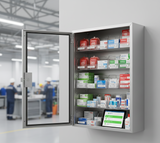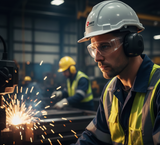More Than a Walk-Through: Your Guide to Effective Workplace Safety Inspections
In the bustling day-to-day of running a business, it's easy to view safety inspections as just another item on a compliance checklist. We might do a quick walk-through, glance at a few areas, and deem everything "fine." However, an effective safety inspection is far more than a casual stroll; it's a critical, proactive tool for identifying hazards, preventing accidents, and safeguarding your employees and your bottom line.
A superficial inspection can leave unseen dangers lurking, ready to cause serious injuries, costly downtime, and significant legal and financial repercussions. A thorough, systematic approach, on the other hand, can catch potential issues long before they become incidents.
At Your Safety Company, we understand that robust safety management relies on diligence and precision. Let’s move beyond the casual walk-through and explore how to conduct truly effective workplace safety inspections.
Why Inspections Go Beyond Compliance
Effective safety inspections are a cornerstone of a strong safety culture because they:
-
Identify Hidden Hazards: Catch issues like worn equipment, improper storage, or blocked exits before they cause harm.
-
Ensure Regulatory Adherence: Help confirm your workplace meets all relevant safety standards.
-
Prevent Accidents & Injuries: Proactive identification and correction of hazards directly reduce the risk of incidents.
-
Improve Employee Morale: Demonstrates a visible commitment to employee well-being, fostering trust and engagement.
-
Save Money: Prevent costly workers' compensation claims, equipment damage, and production delays.
-
Promote Continuous Improvement: Provide valuable data for ongoing safety program enhancements.
The Anatomy of an Effective Safety Inspection
Turning a simple walk-through into a powerful safety tool requires planning, attention to detail, and follow-through.
-
Plan Your Inspection:
-
Define Scope: What areas, equipment, or processes will you inspect? Is it a general inspection or focused on a specific hazard (e.g., fall protection, electrical)?
-
Frequency: Establish a regular schedule (daily, weekly, monthly, annually) based on risk levels and regulations. High-hazard areas need more frequent checks.
-
Checklists: Develop clear, comprehensive checklists tailored to specific areas or equipment. These ensure consistency and prevent oversight.
-
Team Approach: Involve a diverse team, including managers, supervisors, and front-line employees from the area being inspected. They offer different perspectives and insights.
-
-
Conduct the Inspection – Look, Listen, and Ask:
-
Be Systematic: Follow your checklist methodically. Don't rush.
-
Observe Actively: Look for things out of place, damaged equipment, improper procedures, or missing PPE. Don't just look for "what's wrong," look for what could go wrong.
-
Listen: Pay attention to unusual noises from machinery or comments from employees.
-
Talk to Employees: Ask employees about their concerns, difficulties, or near misses. Their input is invaluable.
-
Check Environmental Conditions: Look at lighting, ventilation, temperature, and housekeeping.
-
Document Everything: Take detailed notes, photos, and even videos if helpful. Record both safe conditions and identified hazards.
-
-
Prioritize and Take Action:
-
Categorize Hazards: Classify identified hazards by severity and likelihood (e.g., immediate danger, serious, minor).
-
Assign Responsibility: Clearly assign who is responsible for correcting each hazard.
-
Set Deadlines: Establish realistic but firm deadlines for corrective actions.
-
Immediate Action: Address any "imminent danger" hazards immediately by stopping work or implementing temporary controls until a permanent fix is in place.
-
-
Follow-Up and Review:
-
Verify Completion: Ensure all corrective actions have been completed by their deadlines.
-
Document Resolution: Record when and how each hazard was corrected.
-
Analyze Data: Periodically review all inspection reports and corrective actions. Look for trends, recurring issues, or areas that consistently pose risks. This informs continuous improvement of your safety program.
-
Communicate Findings: Share inspection results and corrective actions with the relevant teams and management. This reinforces transparency and commitment.
-
Your Safety Company: Your Partner in Diligent Inspections
Effective workplace safety inspections are a testament to a business's dedication to its employees' well-being. By moving beyond a cursory glance and embracing a detailed, proactive approach, you safeguard your team and your operations from preventable harm.
At Your Safety Company, we provide essential products that support every stage of your safety inspection process:
-
Flashlights and Headlamps: For clear visibility in all areas.
-
Safety Vests and High-Visibility Apparel: To ensure inspectors are seen and safe in active work zones.
-
First Aid Supplies: For immediate response if an unforeseen incident occurs during an inspection.
-
Safety Signage and Labels: To mark hazards identified during inspections, or to replace damaged warnings.
Don't let vital hazards go unnoticed. Visit yoursafetycompany.com today to explore our comprehensive range of safety solutions that equip your team for thorough and effective workplace safety inspections.
Recent Posts
-
Beyond the Big Box: Why Yoursafetycompany.com is the Smarter Choice for Your First-Aid Program
When it comes to workplace first aid, ensuring your business is compliant and your employees are pro …1st Jan 2026 -
The 2026 Safety Checklist: Is Your Crew Truly Protected?
As we move into the new year, it’s the perfect time to look past the daily grind and evaluate the ge …23rd Dec 2025 -
Beyond the Buzz: Why Proper Hearing Protection is Non-Negotiable on Your Job Site
On any given workday, the sounds of progress—drills, saws, heavy machinery, and even loud conversati …22nd Dec 2025



